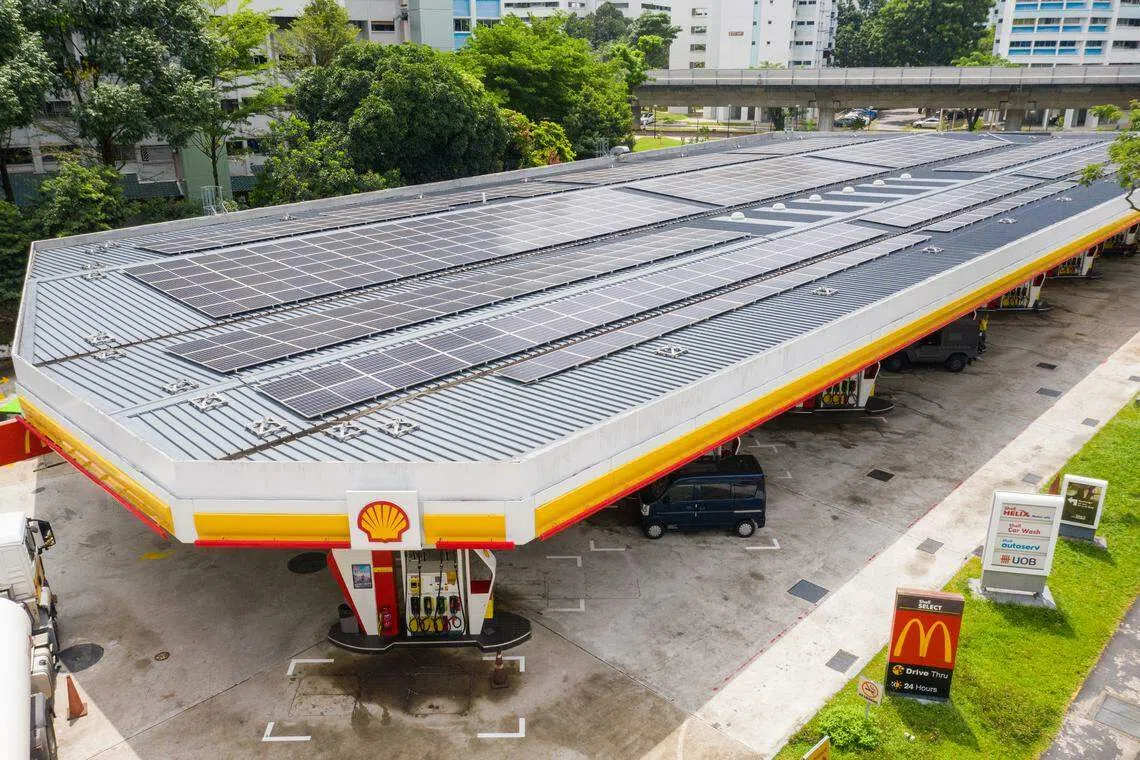EMA and Shell debut first solar-powered green EV charging stations

Derryn Wong
SINGAPORE’S first solar-powered electric vehicle (EV) charging stations were debuted by the Energy Market Authority (EMA) and energy company Shell at an unveiling event on Monday (Aug 7).
The three stations are: Shell Lakeview (80 Upper Thomson Road), Shell Pasir Ris (1 New Loyang Link), and Shell Tampines (9 Tampines Avenue 2). Lakeview is now open to the public for EV charging. The Pasir Ris station will be open from Sep 30, and the one at Tampines from Aug 31.
The power used to charge EVs at these stations is from 100 per cent renewable sources in Shell’s solar energy network, including rooftop installations at 37 stations and at its Tuas Lubrication Plant.
Each station will have two EV charging points and be capable of direct current fast-charging speeds of up to 180 kilowatts (kW). This makes them the fastest EV chargers available in service stations in Singapore, superseding the 150 kW charging station at SPC Bukit Batok. In his speech at the event, Second Minister for Trade and Industry Tan See Leng said that the stations are a “meaningful milestone” in Singapore’s sustainability journey because they help reduce the impact of fast EV charging on the power grid and utilise local renewable resources.
He also cited their significance as an example of how “decentralised energy sources can be integrated in a similar format to optimise power availability at different locations, to enhance grid stability and support our net zero goals”.
The Shell project began following the award of an innovation grant to Singapore energy solutions company Eigen Energy in March 2021 by EMA and Shell, with support from Enterprise Singapore.
The grant was part of EMA’s efforts to support the Singapore Green Plan 2030, which aims to increase the nation’s solar energy deployment to at least two gigawatt-peak of power and support EV growth with 60,000 charging points by 2030.
The project is a “key milestone in our efforts to develop a more sustainable energy future for Singapore, particularly in electrifying our vehicle population and scaling up solar adoption”, said EMA chief executive Ngiam Shih Chun.
According to EMA, findings from this project “can potentially be replicated” and help expand Singapore’s EV charging network.
“We can learn from this pilot to deploy Shell Recharge at locations facing grid constraints to effectively grow Singapore’s EV-charging infrastructure island-wide,” said Doong Shiwen, general manager for Mobility Singapore at Shell.
In response to questions from The Business Times, Doong said that the system could possibly be applied to other locations, including Housing Development Board (HDB) car parks, but that more data and experience would be needed to be gained first.

The stations will use photovoltaic solar panels to provide some of the electricity used for EV charging. When the sun is shining, the solar panels will charge a lithium-ion battery storage system. An energy management system decides when to utilise the batteries or draw power from the grid.
Special attention has been paid to battery safety, with algorithms and sensors in place to detect battery off-gassing, which is the state where lithium-ion batteries swell and emit gases as a precursor to a battery fire.
The battery storage capacity is 178 kilowatt-hours (kWh) for Lakeview and Pasir Ris, and 389 kWh for Tampines. Small EVs have a battery capacity of around 50 kWh, so the latter station, at maximum capacity, will be able to fully charge around seven small EVs.
The battery capacity differs due to the size differences in the stations, as the Tampines station is larger and has a bigger solar panel system with more power output.
Shell and its consortium partner Busways also announced a pilot project to provide charging for larger commercial vehicles, including heavy goods vehicles and buses.
The system will provide fast charging of up to 360 kW, and also test charging of larger EVs within space constraints, but also energy and fleet management solutions.
The consortium currently accepts corporate enquiries for trial tests of e-buses, e-trucks and other heavy-duty EVs. Amendment note: An earlier version of this article incorrectly stated that the EMA’s target for solar energy deployment is 1.5 gigawatt-peak of power by 2030. It is in fact “at least two gigawatt-peak” by 2030. The article has been amended to reflect this change.
Decoding Asia newsletter: your guide to navigating Asia in a new global order. Sign up here to get Decoding Asia newsletter. Delivered to your inbox. Free.
Copyright SPH Media. All rights reserved.


